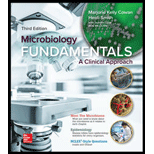
Concept explainers
Which of the following organisms is most problematic with respect to its resistance to antibiotics?
- a. Streptococcus pyogenes
- b. Haemophilus influenzae
- c. Mycobacterium tuberculosis
- d. Bordetella pertussis
Introduction:
Microbes are the smallest living things that are not visible with naked eyes. These microbes are present everywhere. Antibiotics are the drugs that are used to treat infection caused by bacteria. Antibiotics majorly target the protein synthesis pathway because all organisms synthesize proteins through translation machinery.
Answer to Problem 1Q
Correct answer:
Mycobacterium tuberculosis is the most problematic microorganism with respect to its resistance to antibiotics. Therefore, option (c) is correct.
Option (c) is given as “Mycobacterium tuberculosis”.
Explanation of Solution
Justify reasons for the correct statement:
Mycobacterium tuberculosis is the microorganism that has many problems related to its resistance to antibiotics because it is rapidly emerging and changing its gene. It also has a waxy layer that makes the cell impermeable to any stain due to which they remain in the body. So, it is very difficult to develop new antibiotics to cure the diseases caused by Mycobacterium tuberculosis.
Hence, option (c) is correct.
Justify reasons for the incorrect statements:
Option (a) is given as “Streptococcus phyogenes”.
Streptococcus phyogenes will not have any problem with respect to its resistance to antibiotics because strain of these bacteria will remain same and does not have waxy layer. So, it will not create problems related to resistance to antibiotics. Hence, it is a wrong answer.
Option (b) is given as “Haemophilus influenza”.
Haemophilus influenza will not have any problem with respect to its resistance to antibiotics because strain of this bacteria will remain same and does not have a waxy layer. So, it will not create problems related to resistance to antibiotics. Hence, it is a wrong answer.
Option (d) is given as “Bordetella pertusis”.
Bordetella pertusis will not have any problem with respect to its resistance to antibiotics because strain of this bacteria will remain same and does not have waxy layer. So it will not create problems related to resistance to antibiotics. Hence, it is a wrong answer.
Hence, options (a), (b), and (d) are incorrect.
Mycobacterium tuberculosis is the microorganism that has a problem with respect to its resistance to antibiotics because it changes its genome again and again and has a waxy layer.
Want to see more full solutions like this?
Chapter 19 Solutions
Microbiology Fundamentals: A Clinical Approach
- Explain how the hormones of the glands listed below travel around the body to target organs and tissues : Pituitary gland Hypothalamus Thyroid Parathyroid Adrenal Pineal Pancreas(islets of langerhans) Gonads (testes and ovaries) Placentaarrow_forwardWhat are the functions of the hormones produced in the glands listed below: Pituitary gland Hypothalamus Thyroid Parathyroid Adrenal Pineal Pancreas(islets of langerhans) Gonads (testes and ovaries) Placentaarrow_forwardDescribe the hormones produced in the glands listed below: Pituitary gland Hypothalamus Thyroid Parathyroid Adrenal Pineal Pancreas(islets of langerhans) Gonads (testes and ovaries) Placentaarrow_forward
- Please help me calculate drug dosage from the following information: Patient weight: 35 pounds, so 15.9 kilograms (got this by dividing 35 pounds by 2.2 kilograms) Drug dose: 0.05mg/kg Drug concentration: 2mg/mLarrow_forwardA 25-year-old woman presents to the emergency department with a 2-day history of fever, chills, severe headache, and confusion. She recently returned from a trip to sub-Saharan Africa, where she did not take malaria prophylaxis. On examination, she is febrile (39.8°C/103.6°F) and hypotensive. Laboratory studies reveal hemoglobin of 8.0 g/dL, platelet count of 50,000/μL, and evidence of hemoglobinuria. A peripheral blood smear shows ring forms and banana-shaped gametocytes. Which of the following Plasmodium species is most likely responsible for her severe symptoms? A. Plasmodium vivax B. Plasmodium ovale C. Plasmodium malariae D. Plasmodium falciparumarrow_forwardStandard Concentration (caffeine) mg/L Absorbance Reading 10 0.322 20 0.697 40 1.535 60 2.520 80 3.100arrow_forward
- please draw in the answers, thank youarrow_forwarda. On this first grid, assume that the DNA and RNA templates are read left to right. DNA DNA mRNA codon tRNA anticodon polypeptide _strand strand C с A T G A U G C A TRP b. Now do this AGAIN assuming that the DNA and RNA templates are read right to left. DNA DNA strand strand C mRNA codon tRNA anticodon polypeptide 0 A T G A U G с A TRParrow_forwardplease answer all question below with the following answer choice, thank you!arrow_forward
 Comprehensive Medical Assisting: Administrative a...NursingISBN:9781305964792Author:Wilburta Q. Lindh, Carol D. Tamparo, Barbara M. Dahl, Julie Morris, Cindy CorreaPublisher:Cengage LearningEssentials of Pharmacology for Health ProfessionsNursingISBN:9781305441620Author:WOODROWPublisher:Cengage
Comprehensive Medical Assisting: Administrative a...NursingISBN:9781305964792Author:Wilburta Q. Lindh, Carol D. Tamparo, Barbara M. Dahl, Julie Morris, Cindy CorreaPublisher:Cengage LearningEssentials of Pharmacology for Health ProfessionsNursingISBN:9781305441620Author:WOODROWPublisher:Cengage
 Medical Terminology for Health Professions, Spira...Health & NutritionISBN:9781305634350Author:Ann Ehrlich, Carol L. Schroeder, Laura Ehrlich, Katrina A. SchroederPublisher:Cengage Learning
Medical Terminology for Health Professions, Spira...Health & NutritionISBN:9781305634350Author:Ann Ehrlich, Carol L. Schroeder, Laura Ehrlich, Katrina A. SchroederPublisher:Cengage Learning





